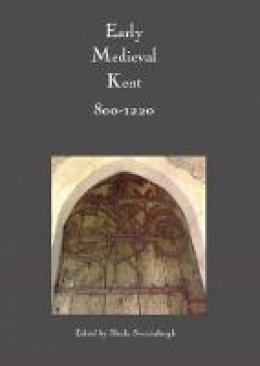
Stock image for illustration purposes only - book cover, edition or condition may vary.
Early Medieval Kent, 800-1220 (Kent History Project)
Sheila Sweetinburgh
€ 81.03
FREE Delivery in Ireland
Description for Early Medieval Kent, 800-1220 (Kent History Project)
Hardcover. Essays on the most important aspects of Kent's history at a time of great growth and change. Num Pages: 352 pages, 2 black & white illustrations, 11 colour illustrations, 11 black & white line drawings. BIC Classification: 1DBKESK; 3H; HBJD1; HBLC1. Category: (P) Professional & Vocational. Dimension: 243 x 166 x 27. Weight in Grams: 904.
Duke William's march through Kent on his way to London after Hastings in 1066 is testimony to the importance of the county. So too are the royal fortifications at Canterbury, Dover and Rochester, and the mostly successful strategy of ruling Kent through a partnership of Crown and Church. The religious communities at Canterbury Cathedral and St Augustine's became two of the premier monasteries in England, and (following the death of Thomas Becket) international centres of pilgrimage. Yet, as well as times of triumph, these four hundred years witnessed massive difficulties for the people of Kent, and England. Viking incursions in two major phases covering two centuries were instrumental, for example, in the loss of most royal nunneries in Kent and the sacking of Canterbury in 1011. Socially, too, this was a formative period in the county's history. Colonization and rural settlement were shaped by the varied physical landscape, but also by matters of lordship and landholding that together marked Kent as distinctive, which would later become enshrined in the Customs of Kent (1293). Similarly the growth of numerous small towns, especially coastal and inland ports, highlight the vitality of the county's commercial development; the provision of ship service to the king by the confederation of the Cinque Ports denotes a special relationship that still exists today. These essays provide insights into a range of topics of importance in the history of Kent during this seminal period. To provide a context for these, the opening essay presents an assessment of the kingdom of Kent. Subsequent chapters consider the development of first rural and then urban society, the impact of the Vikings, pilgrimage and the landscape, literacy and learning, the developing monastic way of life, and parish church architecture. Three multidisciplinary chapters discuss Canterbury as a case study, while a gazetteer of place-name elements closes the book. Sheila Sweetinburgh is an Associate Lecturer at the University of Kent. Among her numerous publications she has edited Later Medieval Kent, 1220-1540 Contributors: Paul Bennett, Mary Berg, Stuart Brookes, Nicholas Brooks, John Cotter, Paul Cullen, Gillian Draper, Diane Heath, Hilary Powell, Andrew Richardson, Sheila Sweetinburgh, Jake Weekes.
Product Details
Publisher
Boydell Press
Format
Hardback
Publication date
2016
Condition
New
Weight
904g
Number of Pages
347
Place of Publication
Woodbridge, United Kingdom
ISBN
9780851155838
SKU
V9780851155838
Shipping Time
Usually ships in 7 to 11 working days
Ref
99-11
Reviews for Early Medieval Kent, 800-1220 (Kent History Project)
This is an excellent volume... multifaceted and rich...methodologies drawn from landscape studies, history, archaeology, ecclesiastical and architectural history, and biography, all offer keen insights. More significantly, the range of discussion presented in the volume allows the reader to make connections between disparate events, objects, sites, and figures in early medieval Kent, and to understand the ripples they sent across medieval England more widely. ARCHAEOLOGICAL JOURNAL Will be a great value to anyone interested in early medieval Kent... it is much more than a 'county history', however: this book represents an impressive amount of scholarship and deserves a wide readership. MEDIEVAL ARCHAEOLOGY This is decidedly recommended reading for anybody who is seriously interested in the medieval history and archaeology of Kent. JOURNAL OF KENT HISTORY
